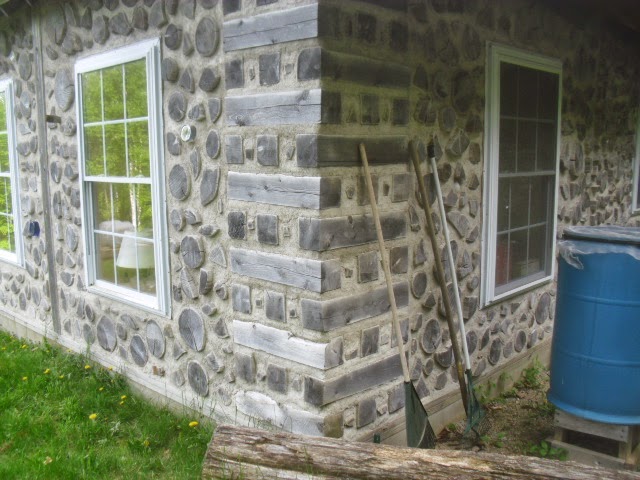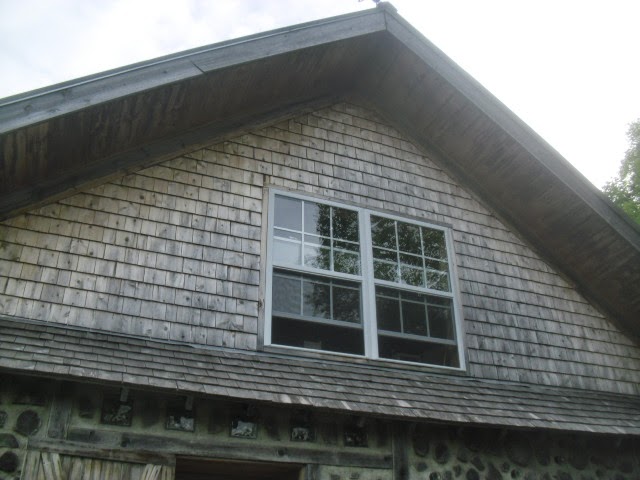Remember that this house is built with a post and beam frame. A square cord wood house, may be subject to racking in high winds. The post and beam help with diagonal stability. Round and oval houses would be less likely to catch the wind that way.
Thursday, June 26, 2014
My Sister's Bathroom
My brother-in-law and my niece built this in a few days to be the main bathroom of their cordwood house. The gas fired toilet was a disaster. The composting toilet did not work properly in the cold. So, this is just a very cute shed on the property. It would make a lovely retreat or spare bedroom. It is actually large enough to be a tiny house.
Notice the concrete pads as in the shed below.
No need to be too fussy with this tiny a structure.
Notice too, the brackets supporting the roof overhang on the front. These could just as well be extensions of the ridge pole and top plates, perhaps decoratively carved or chamfered.
There are no windows in the sides so that privacy could be maintained as a bath, but they could easily be framed for windows and/or a glass door for more light inside.
A Small Shed or Cottage in Maine
Take a look at a post on You Tube called Thoreauvian Simple Living.
Though this shed, near my sister's house in far northern Maine is even larger than the house in the video, it is not as high. Still, at about 12 by 16, or more, it has plenty of space for a small habitation, summer cottage or studio. Notice that it is on pads, just concrete disks actually. As long as there is sheet metal underneath to keep vermin out and insulation, this is perfectly acceptable. The only other caution is that it must be on virgin, well packed soil, or on ledge. Digging below the frost line is always a good idea, so that frost will not heave unevenly and twist your house out of shape, but for this tiny house, with no plaster or plaster board inside, the risk is minimal, and correctable. Fragile but ridgid materials will crack with any movement, but tongue and groove boards will move with the foundation slightly. Just re-level the foundation, and it will slide back in place with only minor complaints.
Wednesday, June 4, 2014
Don't Rush. Don't Be Excessively Cheap
Cutting corners may seem like a good way to save money at first glance. Certainly there are plenty of ways to cut corners effectively. Go to yard sales and thrift shops to buy linens and buy linen dish towels to make curtains etc.. Pre cut so no sewing, spring loaded rods...very easy and cheap.
Old linens that have no special appeal because of antique value can just be worn out cloth...this means you will buy over and over again.
Just an example that came to mind.
When you build, do not build with the first and cheapest materials that come to mind. If you find a lot of boards free on craigslist for instance, they may look like your wall sheathing...a real gift...but in time those boards will not give you the diagonal stability you need. You will never be able to use sheet rock if you do not have that stability. You can, of course, run sheet metal diagonals in your walls under the boards, but there is another expense and time. Just bite the bullet, and use plywood or some other sheet product and do the job right the first time.
Deke Diedrickson has a lot of great shelters built with salvaged materials and corrugated translucent panels, but you simply cannot have quite that mindset with a permanent building. Buy windows that are not all worn out, or be choosy when recycled materials are offered.....why be in the position of having to redo your work. If you come across a nice stained glass panel....that is a different story.
This sometimes means that construction will not be as fast as you would like. Saving up for materials takes some time. Finding just the right salvage will take more time.
You need to be patient and critical of bargains. Think long and hard about purchases and construction methods. It does not always help to be too quick and too cheap.
Old linens that have no special appeal because of antique value can just be worn out cloth...this means you will buy over and over again.
Just an example that came to mind.
When you build, do not build with the first and cheapest materials that come to mind. If you find a lot of boards free on craigslist for instance, they may look like your wall sheathing...a real gift...but in time those boards will not give you the diagonal stability you need. You will never be able to use sheet rock if you do not have that stability. You can, of course, run sheet metal diagonals in your walls under the boards, but there is another expense and time. Just bite the bullet, and use plywood or some other sheet product and do the job right the first time.
Deke Diedrickson has a lot of great shelters built with salvaged materials and corrugated translucent panels, but you simply cannot have quite that mindset with a permanent building. Buy windows that are not all worn out, or be choosy when recycled materials are offered.....why be in the position of having to redo your work. If you come across a nice stained glass panel....that is a different story.
This sometimes means that construction will not be as fast as you would like. Saving up for materials takes some time. Finding just the right salvage will take more time.
You need to be patient and critical of bargains. Think long and hard about purchases and construction methods. It does not always help to be too quick and too cheap.
Subscribe to:
Posts (Atom)

















